|

        
Cologne and Germany's
Rhineland - castles, cathedrals & art...
|
|
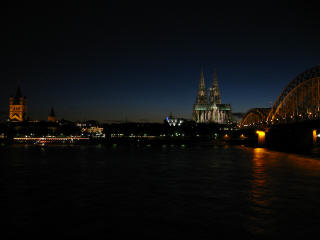
Cologne Cathedral at night from across the Rhine |
I had an opportunity for a European holiday in
conjunction with some business in southern Netherlands.
Cologne was beautiful, artsy and an excellent gateway to
the Rhine and its cities. The all-day cruise down the
Rhine and back was worthwhile, but slow paced. The
weather was nearly ideal in mid-September, allowing me
to visit numerous German town squares in all their
outdoor cafe glory. I continued my pursuit of
art on this trip with museum stops spanning the Roman empire through modern
periods. |
|
|
Friday, September 13th
My trip began with an overnight stopover in London. That's
all the excuse I needed for a pub dinner and to book the show
"We Will Rock You" in the west end. Outstanding performances,
and an incredible concert/play experience for anyone who
enjoyed the music of Queen. There were two encores and three curtain
calls at the performance I attended. A weak story line may
keep this play from having legs after the original cast
disperses. My hotel, the
Chancery Court, was in a good
location for a tube trip from Heathrow (3.6 GBP) and walkable
for the play, but otherwise undistinguished. |
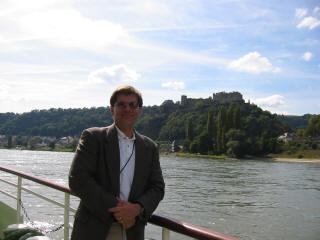
Rheinfels
Castle above St Goar on the Rhine |
|
Saturday, September 14th - Cologne
My first day in Cologne (spelled Köln in Germany) began with
waiting around CGN airport for the currency exchange office to
conclude their hour break. With the Euro now in place,
currency exchange spots are getting more expensive and
lowering their service levels. I took a quick taxi ride to the
Hyatt (~20 Euros), situated across the river from the
Cathedral, and began to explore the city. Cologne is a
compact, walkable city, rebuilt near its original form after
total destruction in WW2. The park by the river (first picture
above) was full of people. It was a short walk to the
Cathedral ("Dom" in German) (outside: second and third
pictures above, inside: fourth picture above and first picture below).
Also inside the Cathedral, the second picture below is the
Shrine of the Three Magi, designed in gold and silver in the
outline of a basilica, with biblical scenes in relief. The Roman Gate across the plaza from
the Cathedral (third picture below) dates from A.D. 50, when
Cologne was a northern boundary of the Roman Empire. I
grabbed dinner at a local restaurant near the plaza and then
headed back to the Hyatt, where I took some night pictures by
the Rhine River facing the city (fourth picture below and
large picture top left of page). |
|
Sunday, September 15th - Cologne Museums & Aachen
On my second day in Cologne I set out to visit its museums.
First up was
Museum Ludwig, beside the cathedral, with four floors of
20th century art. Next up was the
Wallraf
Richartz Museum which spanned several centuries before the
20th, segregated by floors. Neither of these first two museums
allowed pictures, a beef I have with museums in general.
The Kathe Kollwitz
museum was the third, a small but wonderful find, placed on
the fourth floor of a shopping mall. Kathe was an
expressionist influenced by the Nazi rule of her time (first
picture below and more in the Art
section).
In the afternoon I headed to
Aachen by train to see Charlemagne's residence and
cathedral and to learn how to use the trains for my upcoming
destinations. Aachen is about an hour west of Cologne near the
Netherlands border and was the capital of Europe in A.D. 800.
The Aachen Cathedral
dates from Charlemagne's time and was a 20 minute walk from
the train station through a modern, deserted and uninspiring
city. The cathedral (inside: second picture below, outside
from its courtyard: third picture below) is tucked between
many buildings and was partially covered due to restoration.
It is built around an octagon center with pews backed by the
alters. Charlemagne was buried here in A.D. 814. There is a
handy English guide book available for free at the door.
Next door is the Treasury, where artifacts from Charlemagne
and Christianity in general are kept. The treasury was
worthwhile for the 5 Euro entrance fee, having an English
guidebook which was comprehensive, lacking only a map of where
the items it described were. The Altstadt (old city) area near
the Cathedral had a beautiful square backed by its medieval
Rathaus (town hall) with outdoor cafes filled with people. The
town hall stands on the original walls of Charlemagne's Hall
of Kings (fourth picture below). I grabbed an early dinner at
a cafe there and then headed back to the train station to
return to Cologne. |
|
Monday September 16th - Rhine Cruise
In order to see the highlights of the Rhine, it is best to
begin the cruise in Koblenz, which is about 50 miles south of
Cologne at the intersection of the Rhine and Mosel Rivers. I took an early morning express train through Bonn to
arrive in Koblenz for an 8am
K-D Cruise departure.
The paddlewheel ship heads south, which is upstream, past
castles and towns at around 15 to 20 miles per hour. The first
picture below is the yellow and white Schloss Stolenfels. The
second picture below shows the black and white Marksburg
castle, the only surviving medieval castle on the Rhine. Next
up was Rheinfels Castle (large picture top of page right). The
third picture below shows Burg Katz with its castle above a
small town, which was characteristic of most of the sights
along the cruise. The Loreley is the slate rock formation
shown in the fourth picture below, marking the deepest and
narrowest spot on the Rhine. It was once a holy site, but most
of its fame is in the legend of Loreley who tempted sailors to
their death on the nearby reefs. Frankly, it just looks like a
rock. |
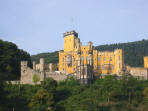 |
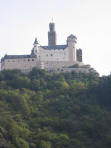 |
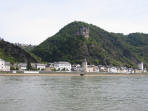 |
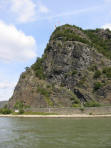 |
|
The classic Rhine view often shown on
postcards is the one shown in the first picture below, Pfalz
Castle on its island in the Rhine backed by Burg Gutenfels on
the hill behind it. Just beyond Pfalz castle, I got off the
boat and toured the small touristy city of Bacharach (translated: alter to Bacchus, the god of wine
- second picture below).
There were wine tastings and shops there, but I was never
impressed by any of the Rhine wines. Weingut zum Gruner Baum
is a good wine bar in the center of the town with tastings
starting in the late afternoon. Rhine wines are mostly whites,
have a low alcohol content, and as such can not be aged for
long. They tended to be overly sweet and lacking in character.
Having had no exercise for the day, I decided
to hike up to Stahleck Castle above Bacharach. From the Castle,
which is now a youth hostel, I had a picture taken of me with
the Rhine valley behind me (third picture below). This
turned out to be a pretty good hike - for a perspective, see
the fourth picture below taken from the Bacharach dock showing Stahleck Castle on the hill in the upper left corner. I
returned to Koblenz on the K-D cruise ship just in time to
watch a sunset in the park where the Mosel and Rhine Rivers
meet. I grabbed the express train back to Cologne after a walk
around the city. |
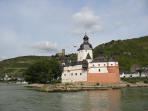 |
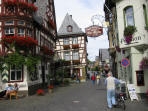 |
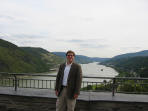 |
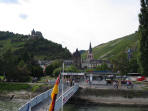 |
|
Tuesday September 17th - Cologne & Düsseldorf
On my final day before beginning the business part of the trip in
the Netherlands, I caught the places I had missed in Cologne
and did some shopping, picking up some
Eau de Cologne at the
spot where it was invented (4711 Glockengasse) as well as souvenirs for the
family. The "pedestrianized"
streets of Cologne around the Cathedral are filled with shops
and people (first picture below). I made a quick stop at the
Chocolate Museum on the Rhine and ate
a good lunch at Fruh am Dom, an
outdoor beer tavern near the Cathedral (second picture below).
Fruh
am Dom is an example of a unique way they serve beer in
taverns
in Germany. Fruh am Dom has its own brew like many
restaurants, which they bring around on a carry tray in .33
liter glasses which look like tall, straight shot glasses.
When your glass is empty, they write a tick mark on your
coaster and give you another glass of beer. When you are ready
to go, they count the ticks and add any food ordered on the
coaster, which becomes your bill.
Since it was only mid-afternoon, I decided to take the 30
minute train ride north to see Düsseldorf. Düsseldorf has a
reputation for being fashion conscious and high priced. Most
people I saw on the streets were definitely well dressed.
Düsseldorf's
Kunstsammlung Nordrhein-Westfalen Museum was having a big
surrealism exhibition covering 1919 to 1944 which I
wanted to see featuring Max Ernst, Joan Miro, Picasso and Dali.
The exhibition was very good, but no pictures were allowed in
the museum. The third and fourth
pictures below show the "Ko", a nice shopping street, and the
old-town area. Düsseldorf is also famous for "Alt Bier" in
their cafes, which is a dark beer that must be consumed
shortly after it is brewed. The outdoor cafe in old town that
I stopped at used the same coaster tick marks that I described
above at Fruh am Dom. To me, Alt Bier tasted like a good
micro-brew beer in the States. |
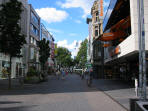 |
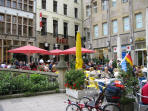 |
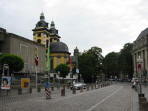 |
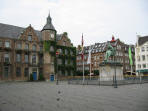 |

                            
Mackey Group, Inc.
© 2002 - 2010
|
|